
Полная версия
Floyd Around the Med
The mushrooms will be even better tomorrow than today.
cream cheese and spinach in filo pastry
The Greeks love these little triangular, puffed, savoury pastries. They are very easy to make and you can use any kind of filling you like. For example, spicy minced lamb in a thick tomato sauce with coriander and chillies; purée of salt cod; or cooked, chopped courgettes instead of spinach. The minced lamb filling would be good with a bowl of that much-loved Greek yoghurt dish, tzatziki (see opposite).
900g/2lb fresh spinach a large knob of butter grated nutmeg 225g/8oz top-quality cream cheese 3 eggs 3 tbsp chopped fresh mint 1 packet filo pastry melted butter for brushing a little beaten egg to glaze sesame seeds sea salt and black pepperCook the spinach with the butter and no water whatsoever in a pan with a lid. Leave to cool, then strain off the liquid and chop the spinach finely. Season with salt and pepper and a little nutmeg. Beat together the cream cheese and eggs, then mix this with the spinach and mint.
To make each pastry, take a sheet of filo pastry and cut a strip about 10 x 20cm/4 x 8 inches. Lay it on a work surface and brush with melted butter. Before you add the filling, turn the top left-hand edge of the pastry over to meet the right-hand straight side (this forms the triangular shape), then unfold it. The mark left will show you where to put the filling. Place a tablespoon of the filling to the right side, refold the corner and seal the edges. Repeat the triangular folding until you have a complete packet. Brush with beaten egg, sprinkle with sesame seeds, place on a buttered baking tray and bake for about 30 minutes in an oven preheated to 200°C/400°F/Gas Mark 6. Serve hot or cold.
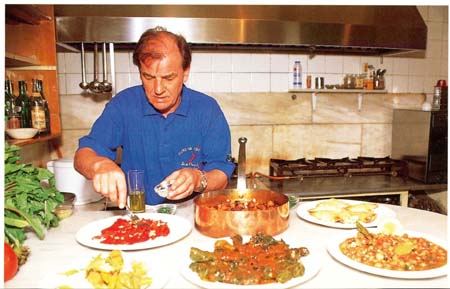
tzatziki
This wonderfully refreshing sauce, dip, starter, call it what you will, is very versatile. It can be used as an accompaniment to simple lamb souvlakia (kebabs), spread on little squares of bread as a snack with your apéritif, or served as a dip to go with mixed, raw vegetables (crudités) such as crisp batons of carrot, celery, spring onion etc.
1 cucumber, unpeeled 500g/1lb 2oz best-quality Greek yoghurt 6 garlic cloves, very finely chopped, then crushed into a paste olive oil wine vinegar sea saltCut the cucumber lengthways in half, remove the seeds with a teaspoon and discard. Grate the cucumber on a cheese grater, put into a colander and sprinkle with sea salt. Leave to drain for 30 minutes-1 hour. Give it a good shake to make it as dry as possible.
Put the yoghurt into a bowl, whisk in the garlic paste and add the cucumber. Stir in well, then stir in a dash of olive oil and a dash of vinegar. Taste it and add a little more olive oil and vinegar if necessary (it must not be too runny). Refrigerate until required.
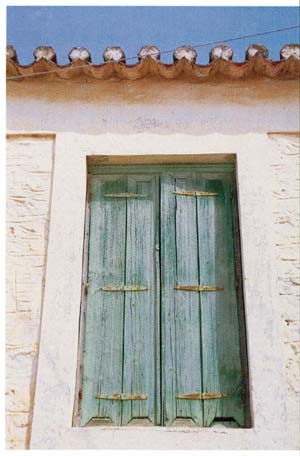
taramosalata
It is hard to find good taramosalata even in Greece. It is invariably made with anonymous fish roe, potatoes, ordinary oil and pink colouring and is, quite frankly, revolting! My version is expensive, excellent and simple. As with all the preceding mezze, this goes well with nicely charred, grilled pitta bread. It will taste even better if you can toast it over a charcoal grill.
2 fat cloves of garlic, peeled 100g/4oz smoked cod’s roe – the best has the skin still attached, which needs to be painstakingly peeled off finest-quality olive oil lemon juice some fine, fresh white breadcrumbsFirst purée the garlic in a food processor, then add the cod’s roe little by little until they are combined. As the food processor goes whizzing around, slowly and evenly pour in a thin stream of olive oil until you have a smooth paste. Next add some lemon juice to taste. Switch off the machine; you may find some olive oil has floated to the top. Switch on the machine again and add some breadcrumbs, a few at a time, until the excess oil has been absorbed.
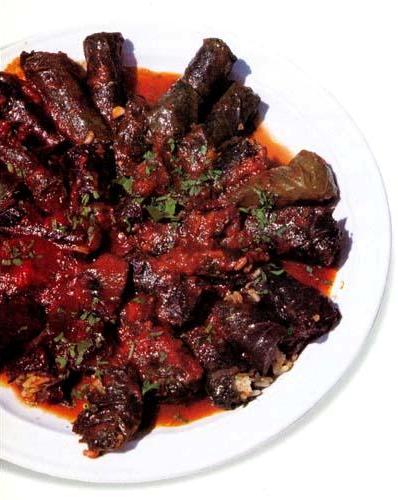
stuffed vine leaves
Because these are fiddly to prepare, and because they are best eaten cold, it is wise to make them the day before you plan to eat them.
You could add finely minced lamb or beef to the filling, cooked with a little tomato sauce like a dry bolognese sauce.
50-60 vine leaves (available in vacuum packs or, if you are lucky, loose in brine from a good specialist food shop) 2 large onions, finely chopped 1 bunch of peppery spring onions, very finely chopped. 1 good bunch of fresh dill, very finely chopped 1 bunch of fresh mint, finely chopped 1½ cups rice, well rinsed, drained and dried olive oil juice of 4 lemons 500ml/18fl oz tomato passata sea salt and black pepper lemon wedges, to serveBlanch the vine leaves a few at a time in lightly salted boiling water, then cool them in a bowl of cold water. Drain and lay out flat on a work surface.
Mix together all the remaining ingredients except the lemon juice and tomato passata, adding a dash of olive oil. Place a small amount of the mixture on each leaf, turn in the sides and then roll them into little sausage shapes. Next, coat the base of a large saucepan with olive oil and cover the bottom with spare vine leaves, unfolded. Then arrange the stuffed vine leaves in circles to cover the bottom of the pan and build up layers until you have used them all up. Add the lemon juice and enough water just to cover the vine rolls. Find a plate or bowl that fits exactly inside the saucepan. Put this on top of the vine rolls to stop them floating up during the cooking process.
Bring to the boil and then simmer gently until the liquid has disappeared and the rice is practically cooked. If there is any liquid left at this stage, carefully strain it off. Now add the tomato sauce and continue to simmer until the rice is fully cooked. Leave to cool and then refrigerate overnight in the saucepan (do not attempt to turn them out while they are warm as they will break up into a shambolic mess!).
Next day, arrange the stuffed vine leaves on a serving dish in a single layer and pour the sauce over. Grind some coarse black pepper over the lot and serve with wedges of lemon.
marinated fish
Here’s one for those of you who happen to like a spot of fishing. If you catch a couple of fish, it doesn’t matter what sort they are at all (of course, you can buy fish from the fishmonger, ho, ho, ho!). But remember that the fish must be very fresh, since it isn’t cooked.
Fillet and skin the fish. Cut the fillets into bite-sized pieces, wash them and dry very carefully. Put them into a shallow earthenware or similar dish, squeeze over some lemon juice and add a dash of white wine vinegar so that the fish is half covered. Chuck in some finely chopped garlic, a couple of crushed peppercorns, a couple of very finely chopped chillies and a dash of olive oil, plus a bit of salt and pepper. Leave in the fridge for one hour and then turn the fish over to marinate the other side. Leave it in the fridge for a minimum of 4 hours (preferably overnight). Serve with fresh bread. The fish is raw but ‘cooked’ by the marinade.
aubergine salad
Another dish that benefits from being prepared the day before as it needs to be chilled and, anyway, the flavours mature nicely this way. Serve spread on cubes of country bread as part of a mezze.
6 aubergines 2-3 tbsp tahini (sesame paste) lemon juice to taste (at least 2 lemons) about 4 tbsp olive oil 6 tomatoes, skinned, deseeded and finely diced (to skin them, drop them into rapidly boiling water for a few seconds; the skins will break and they will be easy to peel) 2 spicy spring onions, very finely diced 1 bunch of fresh coriander, very finely chopped sea salt and black pepperDry-roast the aubergines in a very hot oven until the skins are blackened and charred. Leave to cool. Cut them in half, scrape out the pulp and drain through a fine sieve to extract any remaining moisture. Put the strained aubergine pulp and the tahini into a food processor and whizz to a coarse purée. Tip into a bowl and whisk in some lemon juice and olive oil (it should not be too runny). Then stir in the tomatoes, spring onions and coriander and season to taste. Chill overnight.
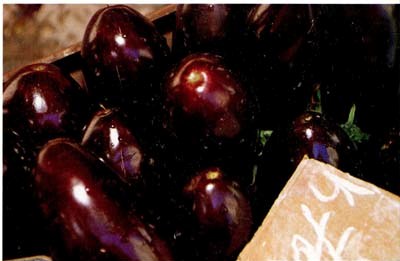
POSTCARDS FROM GREECE
Corfu, April
The journey to Corfu, our first destination in Greece, was miserable. We got to Malaga airport at about 7am with two huge tin trunks full of all my cooking equipment, only to find we had to pay about £700 in excess baggage. Then we discovered that the trunks could not be booked through to Corfu because we had to fly from Malaga to Madrid, Madrid to Athens and Athens to Corfu, and there were no porters in Malaga or Madrid. If we had had to unload the trunks we could not possibly have shifted them. It took four of us to get them on the plane in the first place. However, we finally made it to Corfu at about 1 o’clock the next morning, the Greek Orthodox Easter Saturday, only to find that it was absolutely freezing. We had expected weather similar to Spain and had packed accordingly. To make matters worse we were checked into the most appalling excuse for a hotel I have ever seen in my life. It had no bar, no lift, no lights, the lavatory ran incessantly, the taps dripped and the beds were slatted wooden affairs with thin sponge mattresses. There were no power points, no services or facilities of any kind, except for a breakfast of stale bread and jam plus dreadful coffee made from ground roasted acorns. I can tell you we were feeling very sorry for ourselves, and to make matters worse everybody in the pub before we left had said, ‘Oh, you don’t want to go to Corfu, it’s full of lager louts!’ I was very much in mind of Bob Dylan’s song, ‘You’re lost in worries, it’s raining and it’s Eastertime too.’
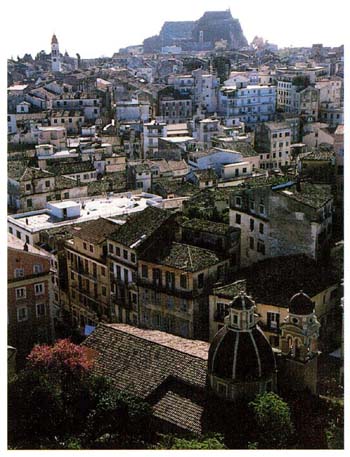
I had a cooking sketch to do that afternoon but because a huge Easter procession was planned, all the shops were shut. Acquiring food was really quite difficult, and trying to buy pullovers and waterproof jackets was a problem, which luckily my wife,Tess, overcame.
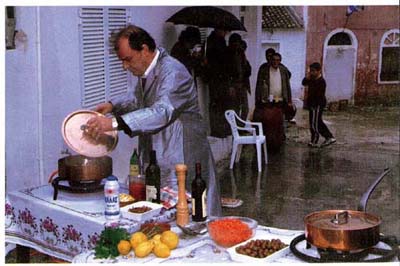
It never rains but it pours.
In between downpours the sun shone brightly, while a very cold wind, which blew in from Albania just a couple of miles across the water, whistled through the narrow back streets of Corfu Old Town. We weren’t due to start filming until about 11 o’clock, so we wandered about the streets and discovered that the Old Town is a charming place: wonderful Venetian architecture, cheerful cafés, bars and restaurants, and an absurd concrete cricket pitch set in the middle of the park for the expats.
As it got closer to 11 o’clock the streets, which at 9 o’clock had been completely empty, began to fill with people – first a few hundred, then a few thousand, then tens of thousands – all lining the route for the grand procession that was to take place to celebrate the resurrection of Christ. In cynical mood, I took my place in the jostling crowds, waiting without any enthusiasm whatsoever for the band to begin to play – some shambolic, out-of-step, scruffy group of people in motley uniforms, banging drums and missing notes on trumpets, I assumed. But to my great delight and excitement I was completely wrong.
The parade was spectacular. The first band came into view and into earshot through a very narrow street, fanning out as the street widened. Its members were dressed immaculately in blue and gold uniforms with polished silver helmets, and playing the most moving music – classical in style but presumably religious. They were succeeded by sombre-looking priests dressed in black with curious stove-pipe hats, flanking a man, berobed but not of the cloth, as it were, who was carrying a huge crucifix draped with a picture of Christ. Then came more processions – of priests, a female choir, scouts, girl guides and children in neat white socks, blue pullovers and blue shorts, and more bands – some dressed in crimson and again playing spectacularly moving music.

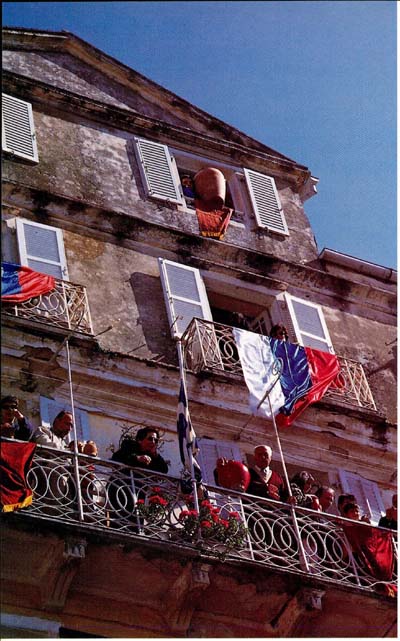
Pot throwing during the Easter Parade in Old Corfu.
It took an hour for the entire musical procession to pass where I stood, and as it fanned out into the wider street the crowd moved in behind it, following it round to the cathedral. After the service, the citizens of Corfu celebrated the Christian resurrection with a pagan ritual. In the times of the ancient Greeks, whenever someone died a member of the family would stay behind as the body was taken away and, as the cortege moved off, would throw an earthenware pot from the house so that it smashed on to the street, warding away evil spirits from the dead and bringing good fortune to the bereaved. Today, of course, this is just a piece of folklore but it’s mightily impressive. Many of the houses in the Old Town are three or four storeys high, all with balconies. Everybody gathers on their balconies and hurls huge clay pots on to the road below. I was doing a piece to camera, pretending to be a famous war correspondent explaining this ritual, when I was actually saved by a Greek policeman who rugby-tackled me out of the path of a down-coming missile. It was damned funny! The crew enjoyed it.
For the next 24 hours, virtually every street in Old Corfu was covered in shattered clay pots. It was like walking on a gravel beach and was hugely good fun. And the sun was shining now, and it really was a pretty place. I believe there were 40,000 people in the streets that day, all crossing themselves as the various parts of the procession passed, and virtually all of them were Greek. The celebration was no cheapskate performance put on for tourists; it was done out of deep belief and longheld tradition.
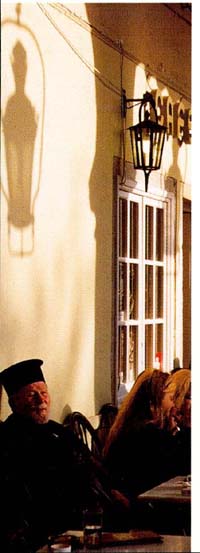
A priest relaxes, while awaiting the Easter parade.
We broke for lunch and I found a little taverna opposite a vegetable shop that had just opened – luckily, so I could buy food for my cooking sketch. It was a curious restaurant, openfronted, very friendly but they didn’t have a kitchen. All the food came from a sort of shed down an alleyway. We had a wonderful plate of grilled octopus, shrimps and sardines and, as it turned out, the only good moussaka that I was to eat on my whole trip. Really delicate, fresh, finely minced lamb topped with a light, cinnamon-flavoured béchamel sauce and served with a crunchy salad of sweet onions, tomatoes, excellent olive oil and good feta cheese. It was delightful and our spirits were high because the procession had been so dramatic – full of pathos yet also a celebration.
That evening there was another Mass, and at 11 o’clock the priests, maybe 120 of them, sort of marched, sort of shambled, sort of glided even, from the church to the bandstand in the park, where all of the bands from the morning were gathered. After a blessing on the tens of thousands of people present, the bands began to play and the music was simply fantastic. Then, as one, they stopped and at that moment a huge red crucifix was switched on, high up on the hill. Simultaneously the night sky erupted in explosions of brilliant fireworks.
Конец ознакомительного фрагмента.
Текст предоставлен ООО «ЛитРес».
Прочитайте эту книгу целиком, купив полную легальную версию на ЛитРес.
Безопасно оплатить книгу можно банковской картой Visa, MasterCard, Maestro, со счета мобильного телефона, с платежного терминала, в салоне МТС или Связной, через PayPal, WebMoney, Яндекс.Деньги, QIWI Кошелек, бонусными картами или другим удобным Вам способом.





